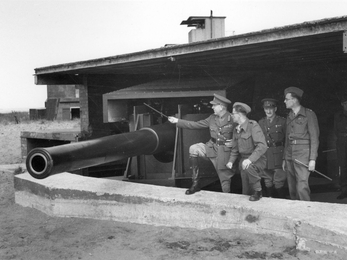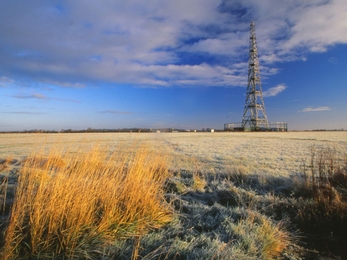Preserved landscapes
Migrating swallows nest in the derelict buildings and common lizards sun themselves on the 19th century walls. It might seem strange, but military landscapes are often some of the best preserved for wildlife. From Civil War battlefields to World War Two airbases, places which have been protected for other reasons can offer a much needed sanctuary for nature, and many Wildlife Trust reserves owe their wild future to a military past. Rich in history and in wildlife, these ex-military reserves are great days out.
As well as offering the opportunity to see amazing wildlife, many of our reserves have an intriguing past
Find a nature reserve with a military history
Do a little research in advance and find out some of the best Wildlife Trust with an intriguing military past.
North
Durham Wildlife Trust
Blackhall Rocks and Cross Gill - Located along Durham's heritage coast, the beach at Blue House Gill was once known as "Dead Man's Beach" when a temporary morgue was set up at the valley bottom as there were so many bodies washed up from shipwrecks during the war. The rugged magnesium limestone coastline hides derelict pillboxes, tank traps and defensive trench systems and is nowadays a stopoff for migrant birds, and home to some rare plants such as butterwort, grass of Parnassus and bird’s eye primrose.
Northumberland Wildlife Trust
Flodden Quarry - There is evidence that King James IV of Scotland, later to become King James I of England, camped at Flodden Quarry in 1513. This disused quarry stands on a hill a mile and a half south of Flodden Battlefield. The battle was a decisive English victory in the long conflict between James IV and the Earl of Surry and his English forces. The quarry now supports gorse, elder, hawthorn, elm, ash, ferns and bluebells, among other things.
Yorkshire Wildlife Trust
Spurn is well known for being an amazing place to see migrant birds - although you need to check the tides to see if you can actually get there! Spurn has been associated with defence since the early 1800s, when a battery of guns were stationed to defend the Humber. During World War One, Spurn was transformed into a military complex, and a road was built in World War Two to enable vehicle access to Spurn Point.
Midlands
Nottinghamshire Wildlife Trust
Mission Carr - This former training area was purchased from the Ministry of Defence by Nottinghamshire Wildlife Trust, after 50 years of restricted public access. In this time, it developed into a wildlife haven and it now contains a variety of habitats including nationally rare wet woodlands, marsh, and old grazing pastures.
Lincolnshire Wildlife Trust
Woodhall Spa Airfield - Woodhall Spa Airfield was formerly the home of four brave RAF squadrons, including 617 ‘The Dambusters’ Squadron, but more recently was used as a sand and gravel quarry. As a nature reserve it is a haven for wildlife as well as a place where visitors can share in the unique and peaceful atmosphere of this former airfield.
South
Alderney Wildlife Trust
Longis Nature Reserve - The Alderney Bird Observatory is one of the best places to spot the travels of many migratory birds and the island as a whole is rich in history, having been occupied by the Germans in World War Two. Longis is surrounded with six Victorian coastal forts and dozens of German bunkers, so it is the perfect place to mix wildlife with history.
Berks, Bucks and Oxon Wildlife Trust
Greenham and Crookham Commons was used as a rifle range and muster point in the Napoleonic wars, and became an RAF airbase used in World War Two (nearby Bowdown Woods nature reserve has an Old Bomb Site storage area). At the end of the Cold War, Greenham housed nuclear warheads called Cruise Missiles, and the airbase was also used between 1973 and 1983 for International Air Tattoo events to showcase military aircraft. Today, the reserve has been invaded by nightjar, woodlark and lapwing, amongst other species.
Devon Wildlife Trust
Bovey Heathfield - On January 9, 1646, this was the site of the Battle of Bovey Heath, a regionally decisive battle during the English Civil War. The site is also a Scheduled Ancient Monument, holding one of only two earthworks in the South West. During the Second World War and for a short time after, American soldiers trained on the heathfield. Today, Bovey Heathfield is a flourishing heathland with reptiles and nightjars to be spotted!
Hampshire Wildlife Trust
Blashford Lakes - Now a haven for wetland birds, the outbreak of World War Two saw this site in the Avon Valley become the RAF Ibsley airfield, used as a base for Spitfires. It was an active airfield, used by 22 RAF Squadrons, for six years, and was used for mineral extraction after being decommissioned in 1946. The derelict RAF Ibsley control tower still stands to the east of the much-loved nature reserve.
Farlington Marshes played a key role during World War Two, as a ‘Q’ decoy site designed to draw enemy bombers from Portsmouth’s docks. Structures mimicking the city’s lights, and decoy fires creating the illusion of the city burning, were built nearby to draw Luftwaffe bombers in. It became the most successful Operation Starfish site in the country; on one night alone in April 1941, over 140 bombers unloaded over 200 munitions on Farlington Marshes and in Langstone Harbour instead of the city of Portsmouth, saving thousands of lives. Control bunkers for this elaborate operation of deception can still be seen around the nature reserve today.
Wiltshire Wildlife Trust
Blakehill Farm - This former World War Two airfield and Cold War listening station was purchased from the MOD by Wiltshire Wildlife Trust in 2000. It is the largest hay meadow restoration project in the UK, one of the rarest habitats in the country. Several Biodiversity Action Plan species make it their home, including skylarks, brown hare and the barn owl.
East
Essex Wildlife Trust
Gunners Park - Several derelict late nineteenth century military buildings at Gunners Park are home to nesting swallows and common lizards basking in the sunlight. The site was used from the mid-nineteenth century until the early 1980s by the School of Gunnery and later the Coast Artillery School, primarily for training Royal Artillery servicemen. The site is also a fantastic place for rare dune plants, invertebrates, butterflies and passage migrants.
Norfolk Wildlife Trust
East Wretham Heath - Between 1942 and 1970, East Wretham Heath was requisitioned for military training and became part of East Wretham Airfield. Today the crumbling runways are home to a miniature garden of wildflowers and thyme. Alongside the runway is an old bunker which has had grids installed, and is used by five different species of bat to hibernate.
Wales
North Wales Wildlife Trust
Gwaith Powdwr, or the Powder Works, was once the largest explosives factory in Europe. It is now a nature reserve managed by North Wales Wildlife Trust for its Lesser horseshoe bats, Nightjar, and reptiles. It played an vital role in both World Wars manufacturing munitions, and evidence of its industrial past can be seen on a walk round the reserve today.
If you can't get to these places
For more information about the special places listed here, or to find alternatives near you, visit your local Trust's website.
More wildlife experiences
From seeing colourful wildflowers to spotting magnificent birds of prey, we can help you get closer to wildlife across the UK.



